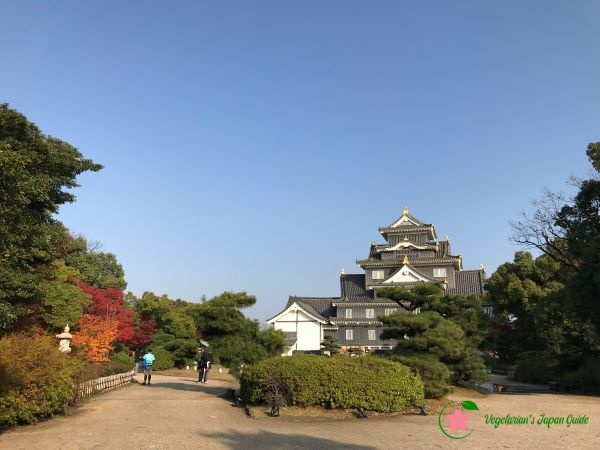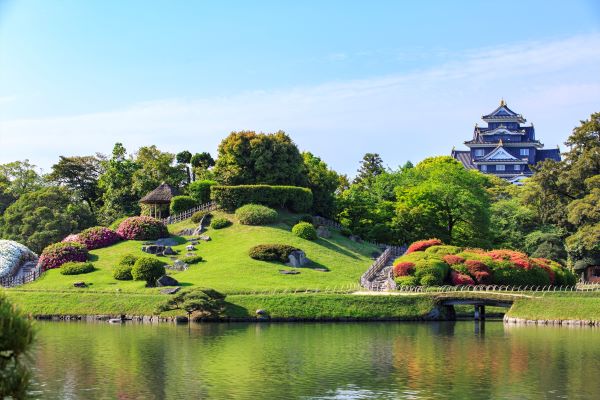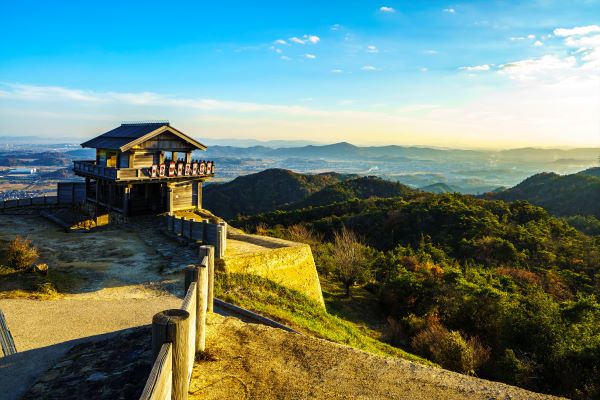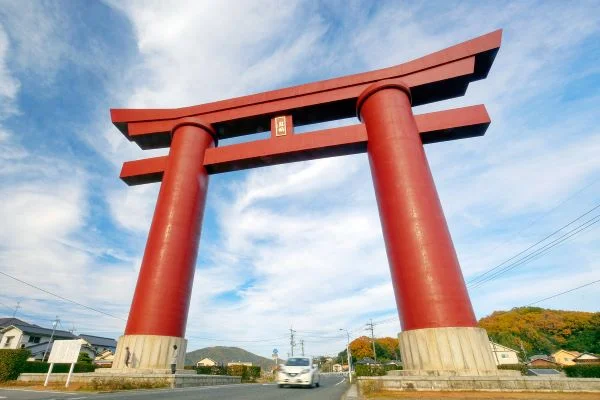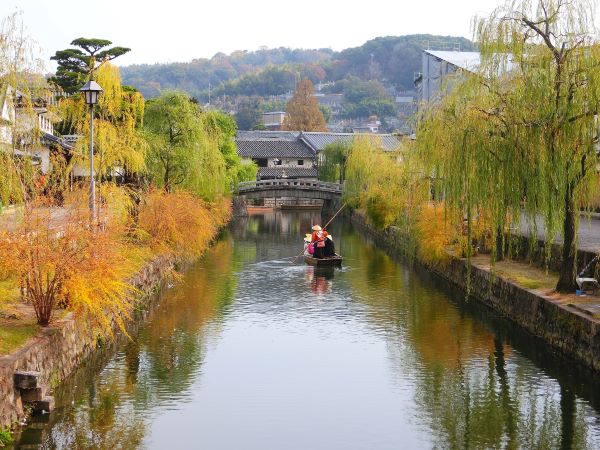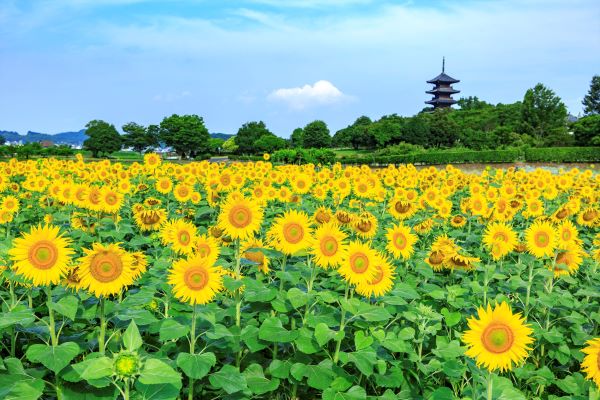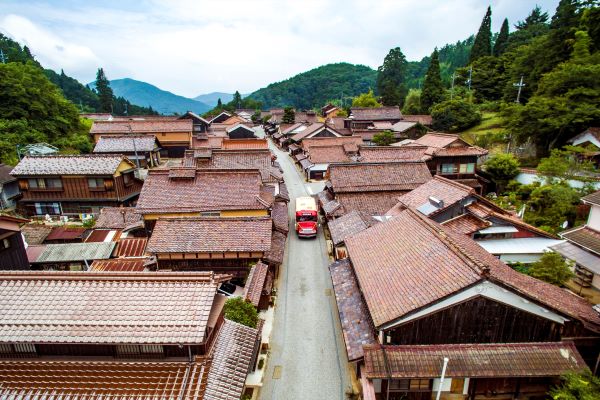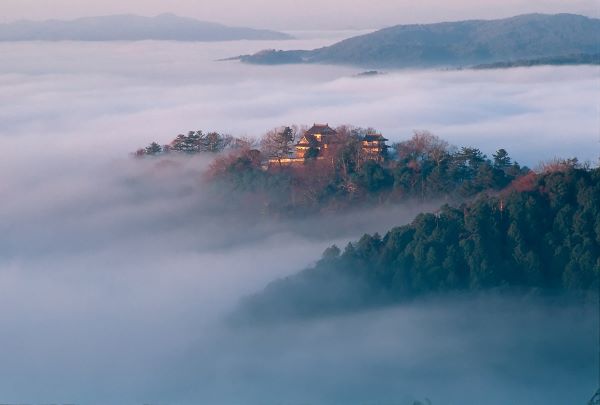Many people know about Okayama because of the famous black Okayama Castle and the garden Kōrakuen, which was chosen to be one of the Three Great Gardens of Japan. But the city is more than just these two top attractions. There is a shrine where you can hear a god’s answer in a boiling pot, a museum full of waving cats made of various materials, a temple where the Naked Festival takes place in February each year, and much more!
If you are unsure where to go when you get off the train at JR Okayama Station, read on!
Here is a list of attractions in Okayama City for you to consider (=゚ω゚)ノ.
- Okayama Castle (岡山城)
- Kōrakuen Garden (後楽園)
- Asahigawa Sakura-michi Walk (旭川さくらみち)
- RSK Rose Garden (RSK バラ園)
- Kibitsu Shrine (吉備津神社)
- Kibitsuhiko Shrine (吉備津彦神社)
- Kinojō Castle Ruins (鬼ノ城跡)
- Saijō Inari (最上稲荷山妙教寺)
- Ryūsenji Temple (龍泉寺)
- Omizuen Garden (近水園)
- Manekineko Museum (招き猫美術館)
- Ukankei Nature Park (宇甘渓自然公園)
- Forest Park Takebe (たけべの森公園)
- Okayama City South Village (岡山市サウスヴィレッジ)
- Kinryozan Saidaiji Kannonin/Saidaiji Temple (西大寺 観音院)
- Inujima Island (犬島)
Tip: Check out the Have Fun in Okayama Pass (1 Week Free Pass). It might be worth it for your itinerary!
Explore Okayama With a Guide
If you prefer a guide to introduce you to the charm of Okayama, how about joining one of the below tours?
- Okayama Half-Day Private Trip with Government-Licensed Guide
- Okayama Full-Day Private Trip with Government-Licensed Guide
- Ukankei Valley Nature Tour
The JR Passes Covering Okayama
- 5-Day JR Hiroshima Yamaguchi Area Pass
- 5-Day JR Okayama-Hiroshima-Yamaguchi Area Pass
- 7-Day Setouchi Area Pass
- 5-Day JR Kansai-Hiroshima Area Pass
- 7-Day JR Sanyo-San’in Area Pass
- 7-Day JR-WEST All-Area Pass
- 7-Day JR Sanyo-San in-Northern Kyushu Area Pass
- JR Whole Japan Rail Pass (Consecutive 7, 14, or 21 Days)
The Cherry Blossom and Fall Foliage Season in Okayama City
- The cherry blossom season in Okayama City is usually from late March to early April.
- Depending on the destinations, the fall foliage season in Okayama City ranges from mid-October to late November.
Exploring Okayama with a Rental Bicycle
As you will find out below, Okayama City has many attractions worth visiting. But they aren’t exactly close to each other. And some aren’t close to a train station or bus stop.
So, how about renting a bicycle around JR Okayama Station to save transportation costs?
In Okayama, there are many bicycle ports in the city center where you can easily rent and return a bike whenever you want. For more details of how this works, please refer to their official website HERE!
And you can follow the CYCLING MAP to visit some of the most popular destinations in Okayama City! For biking in other parts of the Okayama Prefecture, please refer to the same map (=゚ω゚)ノ.
Okayama Castle (岡山城)
Okayama Castle is practically the symbol of Okayama City and Okayama Prefecture.
As one of the Top 100 Japanese Castles, not only can you learn the history of the castle, but you can also participate in some fun activities!
To find out more about what to do and how to get to the Castle, please refer to our Okayama Castle article!
Kōrakuen Garden (後楽園)
Kōrakuen is the garden of Okayama Castle. It is also known as one of the Three Great Gardens in Japan.
To find out more about what to do and how to get to the Garden, please refer to our Kōrakuen Garden article!
The gorgeous beauty of this garden was given a Michelin 3-star rating, and the garden’s name actually reminds people of the characteristics of a great leader as the name is part of an ancient leadership philosophy known as “experience hardship earlier, and enjoy pleasure later”!
Asahigawa Sakura-Michi Walk (旭川さくらみち)
In any list of cherry blossom viewing spots in Okayama, the Asahigawa Sakura-Michi Walk must be near the top.
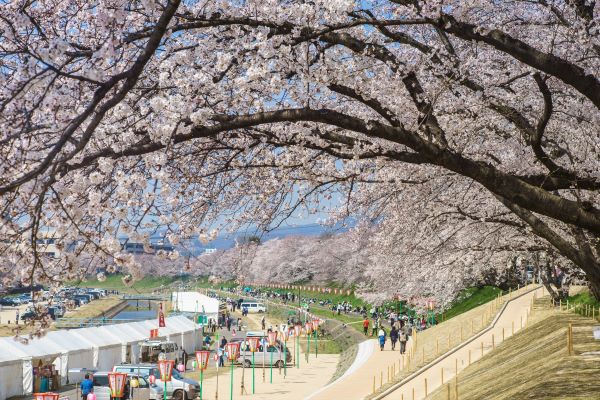
At the east bank of Okayama Kōrakuen Garden, along the Asashigawa River, the cherry blossom trees stretch as far as 1.3 km!
Depending on when the cherry blossoms bloom, the Okayama Sakura Carnival is held each year to entertain the crowd with temporary stalls and nighttime light-up shows.
The cherry blossom usually peaks between late March to early April each year.
Click HERE to return to a list of attractions in Okayama City.
RSK Rose Garden (RSK バラ園)
Just a few stations away from JR Okayama Station, the flowers in the biggest rose garden in the city – RSK Rose Garden – are blooming throughout the year!
Although it’s called “Rose Garden”, there are actually 12 different types of flowers, including 450 varieties of roses planted for visitors to enjoy.
To check out what flowers are blooming in which month, you can refer to their calendar HERE. You can translate the webpage by Google Chrome’s translation function at the right of the address bar.
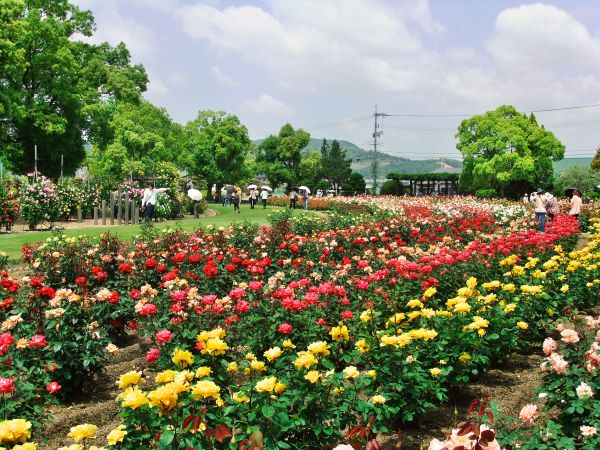
When their restaurant is re-opened, you can have some deliciously made light meals and even a cup of tea with rose honey!
RSK Rose Garden’s Opening Hours, Admission Fees, and Access Information
- The garden is open daily from 9:30 am to 5 pm. From December to March and July to September, the garden is closed on Wednesdays.
- The last admission is at 4:30 pm.
- If Wednesday is a public holiday, the garden will close on the next business day.
- The admission fee is
- 800 yen adults
- 400 yen for elementary school students and younger children
- From JR Niwase Station (庭瀬駅), it is a 5-minute drive.
- From JR Okayama Station (岡山駅), take Nakashō Konbekkusu Line (中庄コンベックス線) operated by Ryōbi Bus (両備バス) and get off at Shimonatsukawa (下撫川). The garden is just a 5-minute walk from the bus stop.
- You can use one of Japan’s Transport Apps to plan your visit.
Click HERE to return to a list of attractions in Okayama City.
Kibitsu Shrine (吉備津神社)
For those who know a bit about Japanese folktales, you most likely have come across the story of Momotarō (桃太郎, “Peach Boy”). And if you haven’t, familiarise yourself with Momotarō’s heroic life before you come to Okayama, especially if you are paying a visit to Kibitsu Shrine (吉備津神社)!
It is a shrine that has a really unique ritual that you might want to participate in. Plus, the 400-meter corridor and the hydrangea flowers are also must see in Kibitsu Shrine’s precinct.
For more information, please refer to our article on Kibitsu Shrine!
Click HERE to return to a list of attractions in Okayama City.
Kibitsuhiko Shrine (吉備津彦神社)

Just a 25-minute walk from the Kibitsu Shrine, there is another shrine with a similar name – Kibitsuhiko Shrine.
A long time ago, Okayama Prefecture was divided into three different countries. So part of the spirit of the god of Kibitsu Shrine – Kibitsuhiko-no-Mikoto (吉備津彦命), was separated to be enshrined in the Kibitsuhiko Shrine to look after the people in the country next door.
Kibitsuhiko Shrine is also known as the Asahi-no-Miya (朝日の宮). On the summer solstice day, the sun rises right in front of its torii gate. The sunlight directly shrines onto the mirror in the worship hall, which the locals believe makes the god of the Shrine extra powerful.
What is worthwhile mentioning is one of the charms and the fortune slip come in the shape of a peach!

Leaving the effectiveness and the accuracy aside, they are just too cute not to get one (≧▽≦).
Opening Hours and Access Information of Kibitsuhiko Shrine
- The Shrine is open from 6 am to 6 pm.
- The office of the Shrine is open from 8:30 am to 5 pm.
- From JR Bizen-Ichinomiya Station (備前一宮駅), it is just a 3-minute walk to the Shrine.
Kinojō Castle Ruins (鬼ノ城跡)
If you ever wondered where the demons in the Momotarō folktale came from, the answer is the Kinojō Castle, located northwest of Kibitsu Shrine.
For more information, please refer to our Sōja City (総社市) article!
Click HERE to return to a list of attractions in Okayama City.
Saijō Inari (最上稲荷山妙教寺)
Saijō Inari is a special place as it is one of the few spots in Japan that combines Buddhism and Shintoism. It is also one of the major Inari Shrines in the country (the other two are Fushimi Inari Taisha (伏見稲荷大社) in Kyoto and Toyokawa Inari (豊川稲荷) in Aichi).
In addition to the delicious monk cuisine that you can taste in one of the halls, you will get a magnificent view from the inner shrine.
For more information, please refer to our Saijō Inari article!
Click HERE to return to a list of attractions in Okayama City.
Ryūsenji Temple (龍泉寺)
Another spot in Okayama that relates to Kibitsuhiko-no-Mikoto (吉備津彦命) is the Ryūsenji Temple. But instead of the Momotarō folktale, the legend of the Temple is related to a dragon god.
For the full story, please refer to the Temple’s website HERE.
The special thing about Ryūsenji Temple is that it is the perfect place to admire the autumn foliage from mid to late November!
There are thousands of stunning red maple trees on the ground of the Temple. And the best thing is, it is still a less-known spot for fall foliage, even amongst the locals.
So although it will take a bit of effort to get to Ryūsenji Temple, it will be worth every bit of effort if you try to avoid the massive crowd!
In spring, the plum blossoms bloom in early to mid-March, followed by the cherry blossoms from late March to early April (^_-)-☆.
Spiritual Training
You might have seen warriors or monks undergoing spiritual training under a waterfall in Japanese animes or dramas. If you ever wanted to experience this, Ryūsenji Temple is a must-visit for you!
You can borrow the traditional kimono from the temple for spiritual training. Please inform them in advance by calling +81-86-295-0130 between 9 am and 5 pm.
Important: Consider your physical stamina before you decide to participate in this activity. The Temple won’t take responsibility in case of any accidents.
How to Get to Ryūsenji Temple
From Bitchu-Takamatsu (備中高松駅) it is a 10-minute drive.
If you enjoy hiking, you can actually hike from Saijō Inari’s Hachijōiwa (八畳岩), which takes around an hour to get to Ryūsenji Temple.
Click HERE to return to a list of attractions in Okayama City.
Omizuen Garden (近水園)
Apart from the Kōrakuen Garden, the Omizuen Garden is another scenic garden you can visit when you come to Okayama.
Designated as a prefectural scenic spot in 1959, the garden has a ground of 5,500 square meters. If you are seeking a spot with the best view, then make sure you stand in front of the Ginpukaku, which is the two stories house in the garden (=゚ω゚)ノ.
Omizuen Garden is also a great place to be for fall foliage admiration!
Opening Hours and Access Information of Omizuen Garden
- The garden is free to enter.
- Ginpukaku (吟風閣) is open from 9:30 am to 4:30 pm daily except Monday, the next business day of any public holidays, as well as from the 29th of December to the 3rd of January.
- If Monday is a public holiday, it will close on the next business day instead.
- From JR Ashimori Station (足守駅), it is a 5-minute drive.
Click HERE to return to a list of attractions in Okayama City.
Manekineko Museum (招き猫美術館)
Especially if you are a business owner, when you come to Japan, remember to bring back a beckoning cat – a Manekineko – to help you attract more good customers!

Apart from the standard Manekineko, which is white in color, there are also other variations. From the one that weighs 100 kg and is made from a camphor tree to the small one made of Japanese washi paper, the Manekineko Museum is definitely the best spot to get a beckoning cat or lucky cat for a boost of good fortune (≧▽≦).
Important: Just to be clear, the ones on display are not for sale. The trading activities only take place in the museum’s shop!
Manekineko Painting Workshop
Instead of bringing one of the cats from the museum’s shop, you should be able to build a better connection with the lucky cat if you paint it yourself (and therefore get even more benefits from it)!
- The workshop occurs every day when the museum is open from 10:30 am to 5 pm.
- The last admission is at 3:30 pm.
- As the number of people that can participate is limited, you can reserve your spot by make a booking through Viator.
- It will cost you 1,700 yen to join this activity.
- For more information, please refer to the museum’s website HERE.
Manekineko Museum’s Opening Hours, Admission Fee, and Access Information
- The museum is open from 10 am to 5 pm daily except Wednesday and from the end of December to the beginning of January
- The last admission is at 4:30 pm
- The admission fee is
- 600 yen for adults
- 300 yen for elementary and junior high school students
- You can also purchase the admission ticket through Klook.
- From JR Okayama Station (岡山駅), it will take 8 minutes by train to JR Bizen-Hara Station (備前原駅). From there, change for a taxi that will take around 10 minutes
- You can also take a taxi straight from JR Okayama Station which will take around 20 minutes and cost you around 3,000 yen.
Click HERE to return to a list of attractions in Okayama City.
Ukankei Nature Park (宇甘渓自然公園)
Traveling further north of the Manekineko Museum, this park is particularly stunning in spring and autumn! The cherry trees usually blossom in early April and if you want to catch some vibrant color in autumn, come in November (=゚ω゚)ノ.
The Ukankei Nature Park is formed by a valley that stretches for about 4km in the middle of the Ukai River. In summer, chilling in the Ukai River is a great idea before or after some trekking on the park’s well-maintained promenade. In winter, when the red Akahashi Bridge and the surrounding landscape are covered by white snow, it is another incredible painting drawn by nature!
What is worthwhile to mention is the public toilet in the park. Located at the back of a waterfall. Because of its location, this toilet, named as Iwaya-no-Kawaya (岩屋のかわや), is at a spot where you can hardly realize its exitance if you were not told in advance, as it just blends in with the surrounding nature (≧▽≦).
To have a peek at what it looks like, check out the 3rd photo in the Instagram post below in the access information section.
How to Get to Ukankei Nature Park
To get to Ukankei Nature Park, it is more advisable that you drive there yourself or catch a taxi, which takes around 45 mins to get there.
Although bus services stop at the Ukankei bus stop twice a day, it is the return trip at night the bus will pick you up from a JR station and drop you off at Ukankei Nature Park.
- The bus timetable can be found HERE for anyone who is still interested.
- You can use one of Japan’s Transport Apps to plan your visit.
Tip: You can join the Ukankei Valley Nature Tour instead of getting there by yourself!
Stopping at Yanagibashi Observation Square (柳橋展望広場)
If you are driving and visiting Ukankei during the fall foliage season, definitely stop by the Yanagibashi Observation Square, just 500 meters from the entrance of Ukankei Nature Park.
Many people will drive straight through without knowing they are missing out on a great hidden gem for autumn foliage!
Forest Park Takebe (たけべの森公園)
Another great place to enjoy nature throughout the year is Forest Park Takebe. Especially from late March to early May, around 15,000 cherry blossom trees of around 100 species will bloom one after another!
The best thing about this park is you can camp or stay in one of their bungalows around the cherry blossom trees (note not all camping sites are next to the cherry blossoms)! To adorn the gorgeous pink and white flowers, you only need to stick your head out of the tent (≧▽≦).
From mid-July to the end of August, from 9:30 am to 5:30 pm, chill at one of their four pools! One of the pools comes with a slider, and there is also a wave-making pool for anyone looking for some thrill! If you have small kids, the smallest pool only has a depth of 30 cm, making it perfect for them to have some fun as well.
Staying Overnight at Forest Park Takebe
- The campsite usage charges are 2,856 yen, and if you need to rent a tent, it is 2,040 per tent.
- Check-in is from 1 to 4 pm, and check-out is by 11 am the next day.
- You can rent out everything you need for a comfortable camping trip from the Park. For the whole list of items that you can rent out and the rental charges for each of them, refer to the Park’s westie HERE and translate it by Google Chrome’s translation function at the right of the address bar.
- If you need assistance with reading it, please contact us HERE, and we will get back to you.
- If you would like to stay at one of the bungalows instead, the cost is 5,814 yen per night.
- Reservation is essential, which can be booked HERE. You will either need to create an account or use your Facebook account to log in. Again, the website is in Japanese, so let us know if you need assistance.
Important: Please bring your ingredients if you want to cook.
Sunrise at Forest Park Takebe
Another benefit of staying overnight at the Park is the beautiful sunrise. If you are lucky, you even get to see the sunrise and the sea of clouds at the same time (*´ω`).
Important: The Park is located 250 meters above the ground. During the day, the temperature will be around 2 degrees lower compared to the city center. It will be colder in the early morning and at night. So remember to bring enough clothes with you!
Forest Park Takebe’s Opening Hours, Admission Fee, and Access Information of
- Forest Park Takebe is open daily except for Mondays from 9 am to 5 pm.
- If Monday is a public holiday, the Park will close on the next business day instead.
- The park extends its opening hours till 6 pm from late July to August.
- The admission fee is
- 300 yen for adults
- 200 yen for elementary and junior high school students
- It is best to drive to the Park, but if that isn’t possible, catch a taxi from either JR Takebe Station (建部駅) or JR Fukuwatari Station (福渡駅). It will be a 15-minute drive.
Click HERE to return to a list of attractions in Okayama City.
Okayama City South Village (岡山市サウスヴィレッジ)

Okayama City South Village is a vast agricultural facility where you can enjoy fruit picking (especially strawberries) and source fresh local produces.
A flea market also has a large range of goods on the first, third, and fifth Sundays of each month, from 9 am to 12 pm. From craftwork to daily necessities, you can easily spend the whole morning strolling around the stalls in the Village’s third car park!
Fruit Picking at Okayama City South Village
You will have a great time at the Village’s fruit fields if you enjoy picking fresh fruits.
Below is a list of fruits that can be picked at Okayama City South Village and their respective season. Click on the link for more details and what to watch out for. You will need to translate the webpage by Google Chrome’s translation function at the right of the address bar if you don’t read Japanese.
- Strawberries picking: From January to May
- Grape picking: From August to early September
- Blueberries picking: From June to August
- Vegetable harvesting: Various times of the year
The Opening Hours of Okayama City South Village and Its Access Information
- From JR Bizen-Kataoka Station (備前片岡駅), it is a 7-minute walk. Please use the white tower as a landmark
- JR Bizen-Kataoka Station is around 30 minutes by train from JR Okayama Station (岡山駅)
Click HERE to return to a list of attractions in Okayama City.
Kinryozan Saidaiji Kannonin/Saidaiji Temple (西大寺 観音院)

Saijaiji is a temple that worships Kannon Bodhisattva. It is also the first temple of the Chūgoku 33 Kannon Pilgrimage Route.
With a long history dating back to 751, the statues in the temple, as well as the worship halls, are all of great historical and cultural value.
Across the Yoshii River, cherry trees beautifully blossom in spring, and ginkgo trees add color to the temple’s precinct in autumn.
Naked Festival – Saidaiji Eyō (西大寺会陽)
Saidaiji Temple is, however, best known for its Naked Festival – Saidaiji Eyō.
On the 3rd Saturday in February, hundreds of thousands of naked men gather at Saidaiji Temple, hoping to receive blessings and good fortunes from the 14 days ritual. It is fascinating to see how the guys don’t show any sign of feeling cold on a freezing winter night, only wearing traditional underwear!
Although it is extremely hard to be a participant in this event, the festival is filmed by the temple each year for us to watch later on YouTube (=゚ω゚)ノ.
You can also check out photos of the entire ritual on their website HERE.
Opening Hours, Admission Fee, and Access Information of Saidaiji Temple
- The temple is open 24 hours a day, but if you want to explore the interior of the worship halls, please do so from 9 am to 4 pm.
- The admission fee is
- 500 yen for adults
- 200 yen for children
- It is a 10-minute walk from JR Saidaiji Station (西大寺駅)
Click HERE to return to a list of attractions in Okayama City.
Inujima Island (犬島)
Inujima is an artistic island in Okayama City. Fine-quality copper and granite used to be produced from the island’s copper smelter and granite quarry. The foundation stones of the various famous castles (such as Osaka Castle) across Japan might be coming out from Inujima!
Nowadays, the islanders don’t earn their living from heavy industry anymore. Instead, they work with artists and have transformed their hometown into an art paradise through this!
The old houses and the remains of the copper refinery are now artworks themselves. As photography isn’t allowed inside any of these art museums, small or big, you really need to be there personally to experience the impact that these artworks will bring to you (=゚ω゚)ノ.
For more information, please refer to our Inujima Article!
Click HERE to return to a list of attractions in Okayama City.
Explore the Famous Kurashiki Bikan Historical Quarter
Kurashiki Bikan Historical Quarter is a historic area filled with traditional Japanese buildings, perfect for some photography sessions.
With a variety of shops, trendy cafes and galleries in the area, you can easily spend a whole day here without getting bored!
Find out more about this gorgeous part of Japan with our Kurashiki Bikan Historical Quarter article!
Discover the Amazing Natural Scenery in Sōja City
If you like cycling and natural scenery, Sōja City next to Okayama is another nice destination you can consider. In addition to a few cycling roads, the city has a rich natural resources, perfect for those who want to escape from big cities’ hustle and bustle.
For more information, refer to our artcile on Sōja City!


